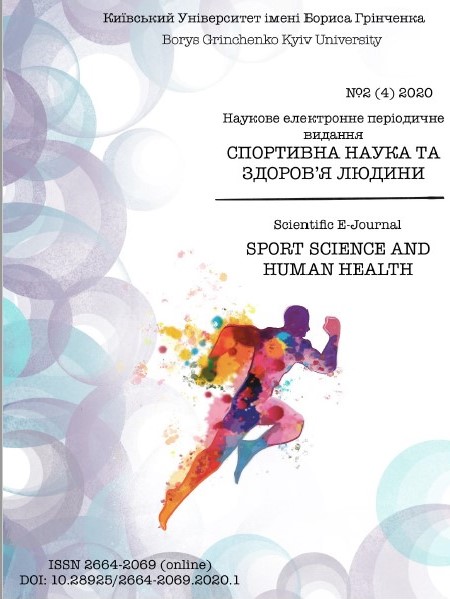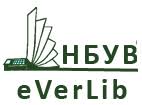CHANGES OF TECHNICAL PREPAREDNESS INDICATORS HIGH SCHOOL STUDENTS ACCORDING TO THE RESULTS OF THE IMPLEMENTATION THE VARIABLE MODULE "WRESTLING" ANNOTATION
DOI:
https://doi.org/10.28925/2664-2069.2020.2.11Ключові слова:
content, means, wrestling, physical education, efficiencyАнотація
Introduction. Modern curriculum («Physical culture 10-11 classes») for the last decades is developed according to requirements of operating standards of basic and full general secondary education. In particular on a modular system
Aim is to find out the changes of technical preparedness of high school students according to the results of implementation the variable module "Wrestling".
Material and methods. There were used theoretical analysis and generalization of scientific and methodical data and sources of the Internet, analysis of documentary materials, pedagogical testing, pedagogical experiment (there was tested the effectiveness of the developed variable module "Wrestling" in the physical education of high school students in secondary schools), methods of mathematical statistics. During the 2017-2019, school years were involved 53 students of 10 classes (31 boys and 22 girls) and 74 students of 11 classes (41 boys and 33 girls).
Results. Analysis of the 10th grade boys’ results indicated the presence of significant changes a high level (p≤0.01). In all cases, the average scores improved by 0.54-0.71 points (from 16.79% to 22.66% of initial level). The girls of the 10th grade best realized the technical and tactical elements standing - dumping, beating (24.76% improvement from the initial level) and on the ground - twists and somersault (24.51%, respectively). For 11th grade boys technical and tactical improvement there was on the level of p≤0.05(9.35–18.45% of the initial level). According to the percentage values for 11th grade girls, in general, there were changes in grades by 10.67–21.13% from the initial level.
Conclusions. It was found that in most technical and tactical elements, girls show higher relative rates of improvement. The only exception is in somersault with running, where the boys had the best changes. The factors of this are the better functional start an organism of young people at the beginning of the pedagogical experiment and higher indicators of fitness, which all owed to better master the technique of the wrestling elements at the beginning of the variable module. The girls gradually increased both fitness and technique of performing theses pacificelements of wrestling.Посилання
Anokhin NV, Karavaev DV. Wrestling as a means of educating physical culture and health of the younger generation. Fizichnakultura i sport v suchasnomu suspilstvi: mater. Vseross. nauch. konf. Khabarovsk, 2005; 6–11. (In Russian).
Balushka L. Influence of means of sports struggle on indicators of physical fitness of lyceum students. Sportivna nauka Ukrainy, 2014; 17–21. (In Ukrainian).
Freestyle wrestling: men, women. Uchebnaya programma dlya detsko-yunosheskikh sportivnykh shkol, spetsializirovannykh detsko-yunosheskikh shkol olimpiyskogo rezerva, shkol vysshego sportivnogo masterstva i spetsializirovannykh uchebnykh zavedeniy sportivnogo profilya. ASBU, 2012; 95. (In Ukrainian).
Dubovis MS, Tsvek SF. Planning of educational work on physical culture in 5–11 classes: metod. rek. Kiyiv: Pedahohichna presa, 2000; 164. (In Ukrainian).
Balushka LM, Tkach YA, Khimenes KR, Okopniy AM, Pitуn MP. The effectiveness of the use of means of struggle in the physical education of students aged 15-16 years]. Naukoviy chasopis Natsionalnoho pedahohichnoho universitetu imeni M.P.Drahomanova. Seriya № 15. Naukovo-pedahohichni problemi fizichnoi kulturi (fizichna kultura i sport): zb. Naukovikh prats. 2020: 3 (123) 20; 9–16. (In Ukrainian).
Ilnitska HS, Ilnitska LV, Ilnitskiy SV. Physical Education. Grade 10. Standard level]. Kharkiv: Osnova, 2018; 112. (In Ukrainian).
Krutsevich TY, Vorobyov MI, Bezverkhnya HV. Control in physical education of children, adolescents and youth: navch. posib. Kyiv: Olimp. l-ra, 2011; 224. (In Ukrainian).
Pistun AI. Wrestling. Lviv: Triadaplyus, 2008; 864. (In Ukrainian).
Stefanishin MV. Differentiation of assessment of physical fitness of schoolchildren of 10-11 grades: avtoref. dis. … kand. nauk z fiz. Vikhovannya ta sportu: 24.00.02. Lviv, 2017; 20. (In Ukrainian).
Curriculum in physical culture for secondary schools 10–11 classes. Riven standartu. 2010; 45. (In Ukrainian).
Curriculum in physical culture for secondary schools 10–11 classes. Riven standartu. 2017; 164. (In Ukrainian).
Stroot SA. Case Studies in Physical Education: Real World Preparation for Teaching. Routledge, 2014; 156.
Reiman MP, Manske RC. Functional testing in human performance. Champaign IL : HumanKinetics, 2009; 308.
Mosston M. Teaching physical education. Merrill Books, 1996; 238.
Stepanchenko NI, Briskin YA. Dispositional factors of personality professional development of the future teachers of physical education and sport. Physical education of students. 2019: 4; 202–208.
Dragnev YV. Modern Reality of Professional Development of a Future Teacher of Physical Culture: Informative-Educational Environment. European Researcher. 2012: (21), 5–2; 657 – 658.
Danylevych M, Romanchuk O, Hribovska I, Ivanochko V. Pedagogical conditions of innovative educational technologies introduction in to the professional training of future specialists in the field of physical education and sport. Journal of Physical Education and Sport. 2017: 17(3); 1113–1119. doi: 10.7752/jpes.2017.03171.
##submission.downloads##
Опубліковано
Як цитувати
Номер
Розділ
Ліцензія
Авторське право (c) 2021 Спортивна наука та здоров'я людини

Ця робота ліцензується відповідно до Creative Commons Attribution-NonCommercial-NoDerivatives 4.0 International License.











